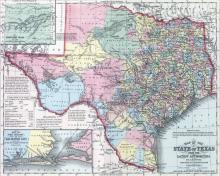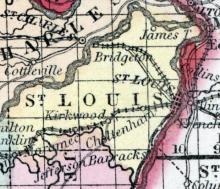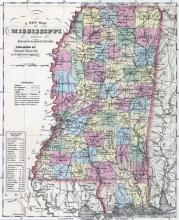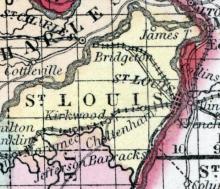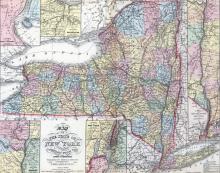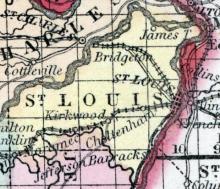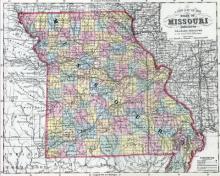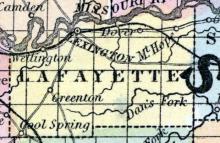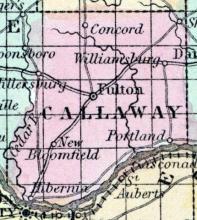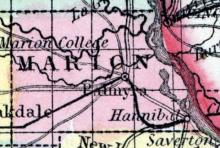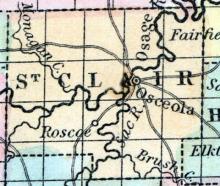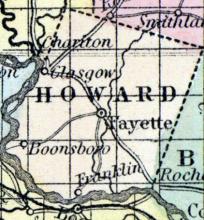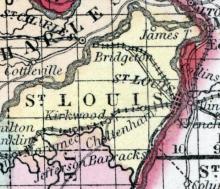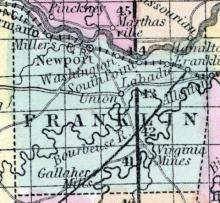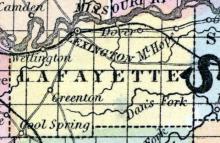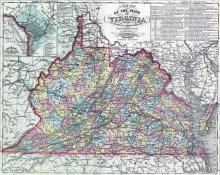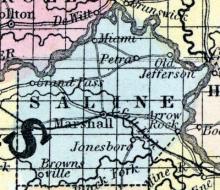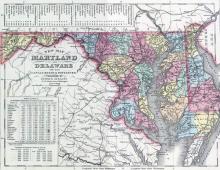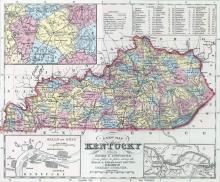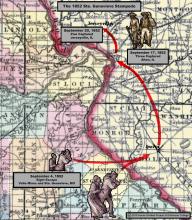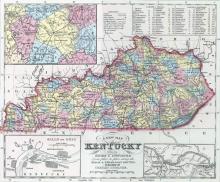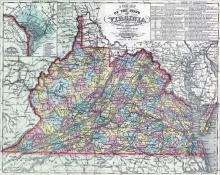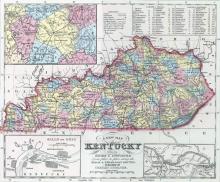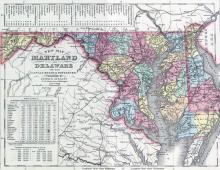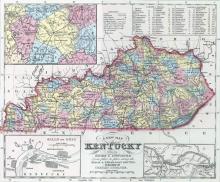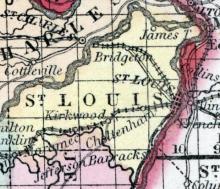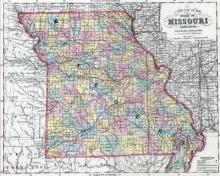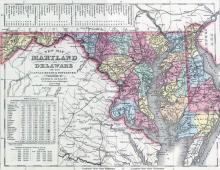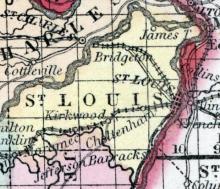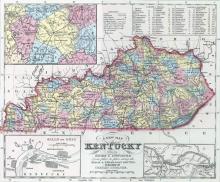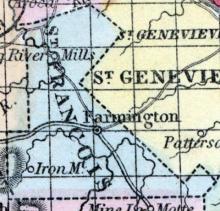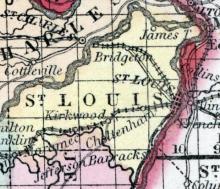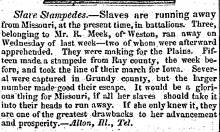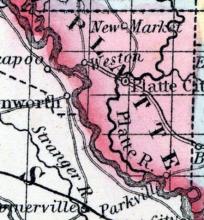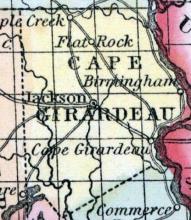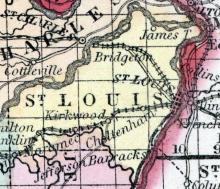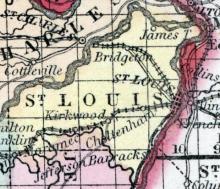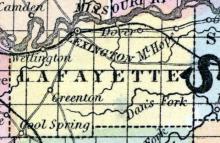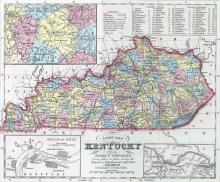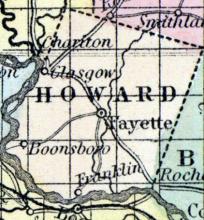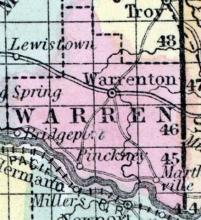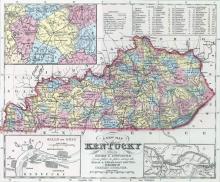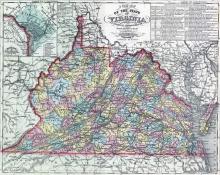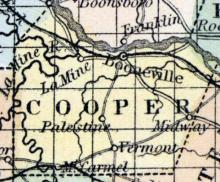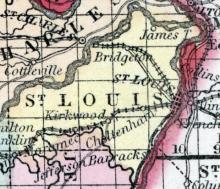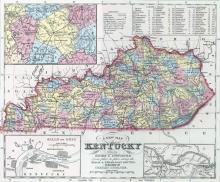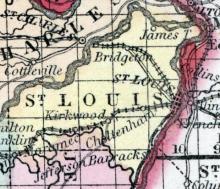Sometime in May or June 1851, a group of "several" enslaved people near LaGrange, Texas made a plan to escape to Mexico. However, one of the prospective escapees set out early, was recaptured, and confessed the whole plot, thwarting the escape.
View All Escapes // 1840s // 1850s // 1860s
Displaying 51 - 100 of 476
During the summer of 1851, an enslaved woman named Missouri, around 24-25 years old, was granted permission to visit her sister in St. Louis, but she "violated the confidence reposed in her and left, and is now at large," slave master Robert Caldwell declared much later.
Three freedom seekers, and a man named B. Thompson who had been sentenced to 10 years in the state penitentiary for "negro stealing," escaped from the Lauderdale county jail in what contemporaries called a "stampede." Along with them was a man named Thomas Boyd, imprisoned for assault and battery.
On Tuesday, April 27, 1852, an enslaved man named Harrison escaped from Bridgeton in St. Louis county. His enslaver, a man named Edwards, advertised a $100 reward for Harrison's recapture.
Reports that a U.S. deputy marshal was in Rochester with warrants under the 1850 Fugitive Slave Act prompted the flight of at least three individuals fearing recapture. According to contemporary accounts, it was believed that these three individuals--and possibly more--had previously escaped from slavery and taken refuge in New York.
A 14-year-old enslaved child named Harris escaped from his enslaver in St. Louis. His slaveholder, P.D. Papin, promised that anyone who recaptured Harris would be "liberally rewarded."
An enslaved person was captured aboard a steamboat en route to Alton, Illinois.
On Monday, May 24, 1852, an enslaved man named Jerry, around 23-24 years old, escaped from Elk Grove in Lafayette county, Missouri. His enslaver, James Backley, advertised a $200 reward for Jerry's recapture.
On June 27, 1852, a roughly 19-year-old enslaved man, who was not named, escaped from Portland in Callaway county, Missouri. His enslaver suspected "there is another Negro man in company with him, who may have free papers," and advertised a $100 reward for the man's recapture.
Sometime during the early summer of 1852, four enslaved people escaped from Palmyra, Missouri. Two were recaptured by an Illinois sheriff near Quincy.
A 26-year-old enslaved man named George escaped from the small village of Ohio in St. Clair County, Missouri. His enslaver, John Means, offered a $150 reward for George's recapture.
On Monday, July 5, 1852, a 22-year-old enslaved man named Bill escaped from Howard county, Missouri. His enslaver, G.W. Walker, Sr., advertised a $100 reward for Bill's recapture.
On Tuesday, July 13, 1852, four enslaved people escaped from St. Louis: 23-year-old George (or William Johnson), who had a free wife in St. Louis, 36-year-old John, 20-year-old Henry, and 16-year-old Isaac. Their enslaver, John Mattingly, advertised a $400 reward for their recapture.
On Thursday, July 15, 1852, a roughly 20-year-old enslaved man named Henry escaped from Beaufort in Franklin county, Missouri. His enslaver, Pierce N. Butler, advertised a $100 reward for Henry's recapture.
Two enslaved people, Barry, held by slaveholder William Spratt, and an unnamed enslaved person held by John J. Reese, were dressed as Indians and helped to escape by two New England-born white emigrants, Samuel and Miriam Clements. The group was overtaken, the freedom seekers re-enslaved and the Clements convicted to two years in the Missouri penitentiary
On Wednesday night, July 28, 1852, six enslaved people, who were not identified by name, escaped from Pendleton county, Virginia. Three were held by a local attorney and slaveholder named Z. Dyer, two by another attorney, Cyrus Hopkins, and another claimed by Elijah Stonestreet. Their ultimate fate remains unknown.
In the summer of 1852, an enslaved man named Abner, around 24 years old, escaped from Jonesboro (modern-day Napton) in Saline county, Missouri. His enslaver, C.E. Smith, advertised a $150 reward for his recapture.
On Saturday night, August 7, 1852, some 14 enslaved people, both men and women, escaped from Washington county, Maryland. All were claimed by a slaveholder identified as Mrs. Pendleton of Hagerstown, Maryland, who had hired out (or rented) the enslaved people to work throughout surrounding Washington county. Pendleton offered a sizable $1,400 reward for their recapture. Days later, the freedom seekers were captured at Harrisburg.
On Tuesday night, August 24, 1852, seven heavily-manacled men escaped from the infamous Arterburn slave pen in Louisville, Kentucky. The Louisville Courier described it as a "stampede," and suspected the seven freedom seekers were "lying out" in cornfields near the city, a common resistance tactic adopted by enslaved southerners. Their ultimate fate is unknown.
On Saturday night, September 4, 1852, eight enslaved workers from the Valle mines coordinated a stampede through Ste. Genevieve. Three of the enslaved men --Isaac, Joseph and Bill-- escaped from Valle Lead Mines in Jefferson county, some 30 miles west. Their escape was coordinated with five other freedom seekers from the town of Ste. Genevieve where the Valle family lived. These young men (all named in a runaway advertisement) included Bernard, Edmund, Henry, Joseph and Theodore.
On Tuesday night, September 7, 1852, eight enslaved people--five men, a woman, and two children--escaped from Mason county, Kentucky apparently "in concert," in what the Maysville Eagle termed a "stampede." Although the fate of the eight freedom seekers is unknown, the group escape prompted calls for slaveholders to ramp up their patrols.
On Saturday, September 25, 1852, an enslaved man named Anderson, aged about 25 years old, escaped from Rocheport in Boone county, Missouri. His enslaver, Moses U. Payne, advertised a $150 reward for Anderson's recapture.
On Saturday night, September 25, 1852, seven enslaved people, who were not identified by name, escaped from Wood county, Virginia for "parts unknown." Six of the freedom seekers were claimed by slaveholding lawyer William Spencer, while the seventh escapee was held by the estate of the deceased enslaver George W. Kincheloe.
On Sunday night, September 26, 1852, a group of 31 freedom seekers escaped from Augusta and Dover, Kentucky. Slaveholders pursued the freedom seekers to Ripley, Ohio, where they found some of the escapees' belongings and managed to recapture three. But African American residents of Ripley threatened to resist the slaveholders' efforts with violence if necessary, and local authorities refused to cooperate with the white Kentuckians.
On Saturday, October 16, 1852, a group of 16 enslaved people escaped from near Hagerstown, Maryland. Fifteen of the freedom seekers were claimed by slaveholding lawyer Elias Cheney, and another person held by lawyer Alexander Mitchell. A $1000 reward was offered for their recapture. Their ultimate fate remains unknown.
On Sunday, October 31, 1852, approximately 25 enslaved people escaped from Bourbon county, Kentucky on horseback. Some of the freedom seekers were recaptured near Blue Licks, Kentucky, while others were believed to have crossed the Ohio river. Several Kentucky slave catchers visited Cincinnati days later, but apparently without success. The fate of the remainder of the freedom seekers is unknown.
An enslaved man named Johnson escaped from St. Louis and made his way to Alton, Illinois, where he was recaptured by two St. Louis policemen.
Two enslaved men and a woman escaped from Boone County, Kentucky in November 1852. With assistance from white abolitionist Levi Coffin in Cincinnati, the three freedom seekers boarded a train. Aboard the train, their slaveholder's nephew, Donn Piatt, recognized the three freedom seekers and persuaded them to disembark with him at West Liberty, Ohio. Piatt promised to steady work and vowed to purchase their freedom. Free Blacks nearby, however, rightly doubted Piatt's motives.
Sometime in early 1853, a slaveholder recaptured a freedom seeker at a black settlement in Illinois called Wood River.
On Saturday night, January 15, 1853, nine freedom seekers escaped from Cumberland, Maryland in a "stampede." Eight of the escapees were claimed by J.G. Lynn, a slaveholding attorney, and the ninth person by another attorney, Joseph Dilley. The nine freedom seekers charted a course some 25 miles into Bedford county, Pennsylvania, where they were overtaken by slave catchers. The eight freedom seekers claimed by Lynn were all recaptured.
An unidentified enslaved man escaped from a St. Louis jail and traversed the Mississippi by steamboat, but his location was given up by a free African American, and Missouri slave catchers recaptured him.
On Saturday night, April 2, 1853, 25 enslaved people escaped from Boone county, Kentucky. Reports suggest they may have travelled north, through Cincinnati to Preble county, Ohio, where Underground Railroad activists reported that "twenty-four Fugitives passed through." This account may have been referencing the same group of freedom seekers.
On Sunday, April 17, 1853, a 23-year-old enslaved man named Jack escaped from Farmington in St. Francois county, Missouri. His enslaver, D. McKenzie, advertised a $100 reward for Jack's recapture.
On Saturday, April 23, 1853, an enslaved man named Lewis, about 25 years old, escaped from St. Louis. His enslaver, Henry L. Tevis, advertised a $100 reward for his recapture.
In mid-May 1853, a group of 15 enslaved people escaped in a "stampede" from Ray county, Missouri, bound for Iowa. "Several" were recaptured in Grundy county, but "the larger number" successfully escaped.
Three enslaved people escaped from slaveholder R. Meek in Weston, Missouri. A report noted that the freedom seekers were "making for the Plains." However, two were later recaptured. Contemporary reports described the escape of these three bond people as part of a wave of recent "slave stampedes" unsettling the institution throughout western Missouri.
In Cape Girardeau, Missouri, an altercation between two enslaved men, Adam and Edmund, resulted in Adam stabbing Edmund "several times with a knife." Edmund's wounds were believed to be fatal, while Adam escaped the custody of the local authorities.
On June 26, a young enslaved woman named Maria, between 18 and 20 years old, escaped from central township outside of St. Louis. Her enslaver, Margaret Boswell, advertised a $100 reward for Maria's recapture.
On Saturday night, July 16, 1853, a roughly 28-29-year-old enslaved man named Jerry escaped from the steamboat George Collier. The captain of the vessel, James W. Goslee, advertised a $200 reward for Jerry's recapture.
On Sunday night, August 14, 1853, four enslaved people escaped from the Henderson, Kentucky residence of slaveholder Jackson McClain. Weeks earlier, an enslaved woman had attempted to set fire to McClain's house, and now the other enslaved people he claimed were openly resisting through what local papers called a "stampede." Then on Monday night, August 15, reports circulated that "five or six more" enslaved people had escaped from McClain.
On Sunday, August 28, 1853, an enslaved man named Thomas Jefferson escaped from Hancock Bottom in Warren county. His enslaver, A.H. Kunzel, advertised a $100 reward for Jefferson's recapture.
On Wednesday night, September 14, 1853, five enslaved people--including three young women--escaped from near Maysville, Kentucky. They crossed the Ohio river near Ripley, Ohio, and managed to elude slave catchers.
Sometime in October 1853, eight enslaved people escaped from Mason county, Virginia. They were claimed by slaveholders named Beale, Bateman, Capehart, and Mrs. Lewis. The freedom seekers' ultimate fate remains unknown.
On October 29, 1853, around 11 enslaved people escaped in what was described as a "stampede" from Palmyra, Missouri. Later in February 1854, a local paper reported that over $15,000 in human "property" had been lost as a result of the enslaved Missourians' mass flight from bondage.
Three enslaved people, Charles, Phillis and Jesse, were helped to escape from Boonville, Missouri by a Canadian man named Francis Moss. They were recaptured, and Moss sentenced to five years in prison.
On Monday night, December 12, 1853, nine enslaved people escaped from Covington, Kentucky. Five of the freedom seekers were claimed by Covington mayor Bushrod W. Foley. They apparently traveled near Cincinnati, passing through Cumminsville, Ohio on their way north, reportedly continuing on to Canada.
Around 30 years old, an enslaved blacksmith named Charles escaped from his enslaver in St. Louis during the winter of 1853-1854. His slaveholder, R. Bartlett, advertised a $400 reward for his return.

